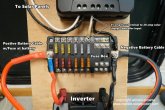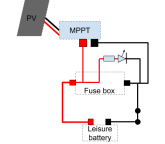Jacko
New Member
- Joined
- Aug 21, 2020
- Messages
- 3
Hi everyone,
I very much like the minimalist circuit wiring presented on this website, because re-using the fuse box for the MPPT makes it really compact.

However, I wonder if the MPPT in this case is not just used to charge the battery but also to power the load directly. Following is the diagram of the relevant pieces of the circuit, with a main switch to cut off the battery. For the load, I added the symbols of a LED (resistance + diode).


When the main switch is closed (left), the MPPT charges the battery, but doesn't it also powers the LED directly? Especially when the main switch is open: there will be no current in the wires connected to the battery (green), but it looks to me like there will still be current pushed through the LED by the MPPT.
If this is the case, is it problematic? I believed MPPT should only be used to charge batteries and not power loads directly.
I very much like the minimalist circuit wiring presented on this website, because re-using the fuse box for the MPPT makes it really compact.

However, I wonder if the MPPT in this case is not just used to charge the battery but also to power the load directly. Following is the diagram of the relevant pieces of the circuit, with a main switch to cut off the battery. For the load, I added the symbols of a LED (resistance + diode).


When the main switch is closed (left), the MPPT charges the battery, but doesn't it also powers the LED directly? Especially when the main switch is open: there will be no current in the wires connected to the battery (green), but it looks to me like there will still be current pushed through the LED by the MPPT.
If this is the case, is it problematic? I believed MPPT should only be used to charge batteries and not power loads directly.


